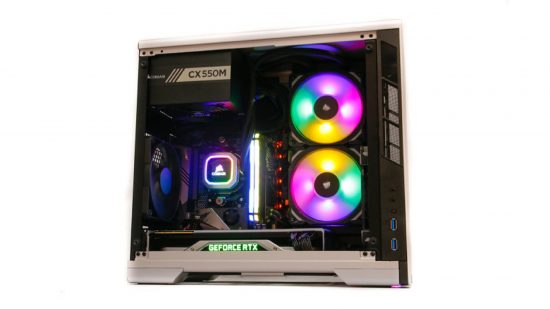Like many people working from home in the UK, I’ve had to contend with a fairly limited amount of space until recently, resulting in me reducing the size of my PC. However, this hasn’t resulted in slower frame rates or lack of power in other departments. Thanks to the small form factor scene really taking off over the last decade, the choice of PC cases, motherboards and other compact hardware has grown, and I honestly haven’t missed the giant PCs I used to own at all.
Mini-ITX has meant that, despite owning a PC with a smaller footprint than a shoebox, it’s been easy to find ways of using high-end desktop processors and graphics cards, along with the latest storage technology. My current PC is more than capable of handling the latest games on my ultra-wide 1440p monitor and, as it’s mine, it’s water-cooled and super-quiet too.
Building a small form factor machine might mean an extra hour or two dealing with cable tidying in the tight confines of a mini-ITX case, but it’s definitely worth it and saves a huge amount of space. The sacrifices are, for most of us, non-existent too, as long as you only need a single PCI-E card. Many mini-ITX cases can house full-length graphics cards, ATX power supplies and hard disks too.
More recently, though, I moved house and now have a much bigger room where my PC is based. With the launch of AMD’s fantastic 3rd-gen Threadripper CPUs and the power that can be had inside an ATX PC now, I’ve been seriously tempted to go back to a full-sized system. Admittedly, I was hoping there would be a micro-ATX TRX40 motherboard, as I’ve had my eye on several micro-ATX cases recently, but sadly it looks as though ASRock isn’t planning a follow-up to its spectacular X399M Taichi board.
Building our front cover water-cooled Threadripper PC a few issues ago inside Phanteks’ gorgeous Evolv X case made this proposition even more tempting. The PC was quieter than my current mini-ITX PC, and it fitted snugly under my desk without taking up too much space, thanks to my new house’s extra room.
However, even though a bigger PC is easier to maintain than a small one (my current system needs half a day to strip down and rebuild if something goes wrong, which is certainly not ideal), I’m still as obsessed as ever with mini-ITX. For me, it’s by far the most interesting form factor of cases and motherboards, and for one clear reason. It forces manufacturers to think differently. Space is usually a huge premium, and this means they can’t approach design in the same way as with ATX cases or motherboards.
The latter, for example, have seen manufacturers placing M.2 ports on the rear of the PCB, large VRM daughterboards and, more recently with the X570 chipset, all manner of ways of cooling the toasty chipset and placing the necessary heatsinks and heatpipes around the motherboard. There’s so much more innovation and variation here than you see between similarly priced ATX motherboards, which is partly why mini-ITX motherboards cost a little more than their equivalent ATX counterparts.
It’s with cases that the really interesting ideas occur though. Again, the variation between the current stack of mini-ITX cases dwarfs that of ATX and micro-ATX models. I still get a buzz looking at them, simply because manufacturers often start from scratch, which is rare with their larger models. The SilverStone LD03 and Phanteks Evolv Shift, for example, are two completely different examples of tower mini-ITX cases.
Previously, we have also looked at NZXT’s H1, which is yet another very different take on this style of mini-ITX case and I love it. It’s even smaller than my Phanteks Shift but is incredibly well thought-out and premium-feeling. Going even smaller, Kolink’s Rocket might not have space for liquid cooling, but it can house a high-end air-cooled PC. Raijintek has several takes on this style of super-small case too, and the Ophion Evo even has space for liquid cooling.
The fact is that, even though I was tempted to go down the ATX route again, I can’t see me ever getting there when companies are still churning out so much great small form factor kit. I’m still working on a Raijintek Ophion Evo case mod, and I can see myself turning my attention to NZXT’s H1 before long too.
One issue is that ASRock’s X299E-ITX/ac motherboard seems to now be at the end of its shelf life, meaning that using Intel’s HEDT CPUs is no longer possible on mini-ITX boards. Thankfully, there are numerous options for using AMD’s Ryzen 9 3950X, though, so whether you need serious multi-threaded grunt or fast frame rates, there are still loads of options. So, despite me getting a bigger place, mini-ITX is still way more interesting to me than any other form factor – I can’t see myself upsizing any time soon.
For a different perspective, check out Richard Swinburne’s treaties on why big PC cases are the way to go.
